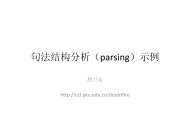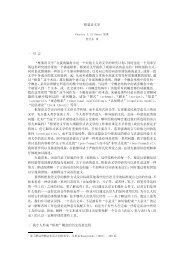A New Perspective On Chinese ZIJI
A New Perspective On Chinese ZIJI
A New Perspective On Chinese ZIJI
You also want an ePaper? Increase the reach of your titles
YUMPU automatically turns print PDFs into web optimized ePapers that Google loves.
As Pollard and Sag argue, this formulation of Principle A, which makes<br />
no reference to such tree-con gurational notions as government and<br />
c-command, accounts for the full range of standard English anaphor<br />
binding facts, as well as a wide array of longstanding counterexamples<br />
to the standard formulation of Principle A (Chomsky 1986).<br />
Notice that this formulation of Principle A requires an anaphor to<br />
be o-bound only if it has a referential local o-commander otherwise<br />
the anaphor is exempt from the binding theory and is subject only to<br />
semantic, pragmatic, and processing-based constraints. Now it is clear<br />
that this principle says nothing about LD anaphors like ziji, norwas<br />
it intended to. To ll this lacuna, following Pollard and Sag (1992a),<br />
we propose a fourth referential type, z-pronoun, together with an<br />
additional binding principle, called Principle Z, given in (38): 8<br />
(38) Principle Z:<br />
Z-pronouns must be o-bound.<br />
It should be noted that in <strong>Chinese</strong>, we must allow for the possibility<br />
that in some positions, either syntactic or discourse binding of ziji is<br />
possible (see examples in (13), (14) and (24)). We arenowinthe<br />
process of developing such an account. Provisionally, the main outlines<br />
of our current theory of ziji are as given in (39):<br />
(39) Analysis of ziji:<br />
i. Ziji is inherently animate, and ambiguous between a zpronoun<br />
(syntactic ziji) and a discourse pronoun (discourse<br />
ziji).<br />
ii. Syntactic ziji must be o-bound by a subject, subject to the<br />
pragmatic constraint of unlike-person blocking. 9<br />
iii. Discourse ziji is subject to the pragmatic constraint ofanimate<br />
blocking.<br />
8 This formulation di ers slightly from that given in Pollard and Sag (1992a).<br />
9 Note that our formulation of subject orientation does not prevent ziji >From<br />
being coindexed with an o-commanding object, as long as it is also coindexed with<br />
an o-commanding subject. Thus, examples like the following are not ruled out:<br />
Zhangsan i<br />
Zhangsan<br />
yao Lisij [PROj xiang<br />
ask Lisi toward<br />
xuesheng jieshao zijii=j.] student introduce self<br />
`Zhangsan i asked Lisi to introduce him i/himself to the students.'<br />
Here PRO denotes not a constituent, but rather the value of the SUBJ feature of<br />
jieshao. See footnote 8.
















